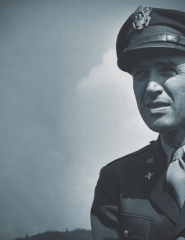James M. Stewart

James M. Stewart
JAMES
M.
STEWART
SOLDIER DETAILS
Distinguished Flying Cross with Oak Leaf Cluster
Air Medal with 3 Oak Leaf Clusters
Army Commendation Medal
American Defense Service Medal
European-African-Middle Eastern Campaign Medal with 3 Service Stars
World War II Victory Medal
Armed Forces Reserve Medal
French Croix de Guerre with Palm
Presidential Medal of Freedom
BIOGRAPHY
While establishing his reputation as an actor, the rest of the world was about to go to war. German occupation in numerous countries in the early part of 1940 led Congress on September 16, 1940 to pass the Selective Service Bill, “the draft.” This bill called for 900,000 men between the ages of 20 and 36 to be drafted each year. Stewart’s draft number was 310. When his number was called and he appeared at Draft Board No. 245 in West Los Angeles in February 1941, the 6’3” Stewart weighed only 138 pounds, 5 pounds under the acceptable weight level. He was turned down for service. Stewart wanted to fly and serve his country but by May of 1941 he would have been too old to get into flight school. He went home ate everything he could that was fattening and went back and enlisted in the Army Air Corps, he passed the physical with an ounce to spare and began his military service as a private. While others tried to avoid the draft, he actually wanted to serve in the military and was the first Hollywood star to enter military service prior or during WWII. As a successful actor in 1935 Jimmy was able to afford flying lessons. He received his civilian pilot’s license in 1935, and bought his first airplane. In 1938 he obtained his commercial pilot’s license. He often flew cross country to visit his parents in Pennsylvania, navigating by the railroad tracks. In the military, he was to make extensive use of his civilian pilot’s training. In March 1941 at age 32, he reported for duty as Private James Stewart at Fort McArthur and was assigned to the Army Air Corps at Moffett Field. To comply with the regulations of the Air Corps proficiency board, Stewart required additional 100 flying hours and bought them at a nearby field, at his own expense. He then took and passed a very stiff proficiency board examination. In January 1942 Stewart was commissioned a 2nd Lieutenant. He was then sent to Mather Field in California as a four engine instructor, this included both the B-17 and B-24 heavy bombers. Much to his dismay, Stewart stayed stateside for almost two years working as a flight instructor, until commanding officers finally yielded to his request to be sent overseas. In November 1943, now a Captain and Operations Officer for the 703rd Bomb Squadron, 445th Bombardment Group of the Eighth Air Force, he arrived in Tibenham, England.
In March of 1944 he was transferred to the 453rd Bombardment Group at Old Buckenham (Old Buc). Throughout his combat career, Stewart flew as lead pilot in B-24 Liberators. Stewart’s war record included 20 combat missions as command pilot over enemy territory, including raids deep into Germany to Berlin. He didn't fly the milk runs, and his missions included bombing raids to Berlin, Brunswick, Bremen, Frankfurt, and Schweinfurt. His most memorable mission, Stewart served as the flight leader of a 1000 plain raid to Berlin. He was awarded the Distinguished Flying Cross with two Oak Leaf Clusters, the Air Medal with three Oak Leaf Clusters, and the French Croix de Guerre with Palm. After the war he remained with the US Air Force Reserves and was eventually promoted to Brigadier General in 1959. In 1966, he participated in a bombing strike in Vietnam, as an observer on a B-52 bomber. He retired from the Air Force in 1968 and received the Distinguished Service Medal and ultimately, the Presidential Medal of Freedom By the end of the war he had risen to the rank of Colonel. Upon returning home his first movie was "Its a Wonderful Life." Courtesy of historynet.com
 Eisenhower Foundation
Eisenhower Foundation
